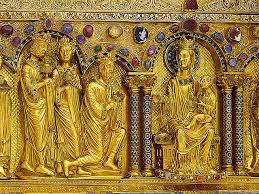 As a child visiting my grandparents, I used to love poring over their twelve volumes of Arthur Mee's Children's Encyclopedia. A wonderful work, in print for an incredible sixty years from the early 1900s! Among the many anachronistic treasures to be found therein were photographs of the great North European cathedrals taken before the terrible destruction visited on so many of them during the second world war. I had them in mind on my recent visit to Cologne in Germany, home of the famous Koelnisch Wasser ('4711' as it's known - my grandmother had a covetably dinky little bottle of it sitting on her dressing table). Cologne, always important for its strategic trading position on the Rhine, is now a modernised industrial city famous for its crazy Easter carnival which lasts six months and for having being bombed to blazes during the war. But happily there are some surviving golden nuggets for the medieval art enthusiast to mine. Most well-known of them is the cathedral, whose blackened twin towers rise into the sky as a testament to the Koelner tenacity and determination to rebuild it from the ruins. The citizens set about the task of rebuilding almost immediately after the war, and work continues to this day. The cathedral houses a magnificent golden shrine to the Magi whose reputed mortal remains have been here since the early twelfth century. I wish I could have got closer to the reliquary, because it is an artwork almost worthy of reverence in itself, made by the incomparable medieval goldsmith Nicholas of Verdun. Instead I lit a candle for a precious family friend whose death we heard of while we were away, and thought of the beautiful Poulenc motet he and I used to sing in the church choir, 'Videntes stellam': teeth-jarringly beautiful dissonances in the second soprano line. "Seeing the star, the wise men were overwhelmed with great joy;and entering the dwelling, they offered to the Lord gold, frankincense, and myrrh. The day of my visit a great deal of noisy pavement construction was going on, and the ambulatory was occupied by a mini-crane with a woman bravely perched thirty or forty feet up in the bucket, dusting a polychrome archbishop with paint brush and vacuum. She noticed me taking the photograph and shot me an old-fashioned look, which is my excuse for the lack of focus. Unfortunately most of my pictures of the interior were either too blurred or too dark to be worth publishing. The second photo below was intended to show the interesting painted gothic beam, looking as if it were originally part of a rood screen - but instead the modern mosaics below the clerestory show up much better. The third grainy photo is of a painted stone side altar which caught my eye, partly for the green and red colour interchange which I love so much and seems so characteristic of gothic art. Also in Cologne I found the Schnuetgen Museum, a cave of medieval treasures - more to follow soon!
|
The view from my deskCurrent work, places and events, art travel, and interesting snippets about Christian icons, medieval art, manuscript illumination, egg tempera,, gilding, technique and materials. Categories
All
Archives
January 2024
|









 RSS Feed
RSS Feed